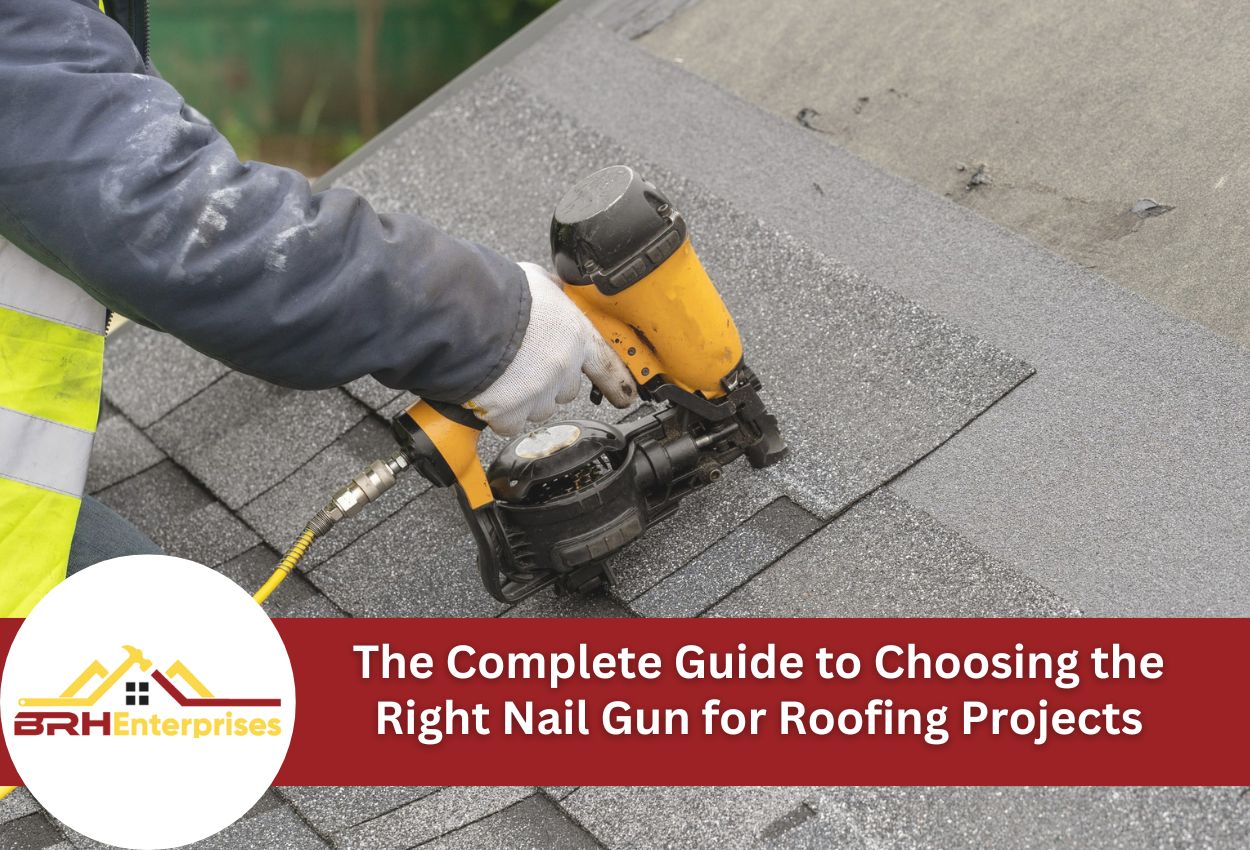The Complete Guide to Choosing the Right Nail Gun for Roofing Projects
Estimated Reading Time : 6 Min.

Selecting the perfect nail gun for roofing work makes the difference between a professional installation and a frustrating experience filled with delays and potential quality issues. Roofing projects require tools that can handle repetitive movements across different materials and weather conditions.
The right roofing nail gun transforms what once required hours of manual hammering into efficient, precise installations. Modern pneumatic roofing nailers deliver the power and speed necessary to secure shingles, underlayment, and other roofing materials with professional results. These specialized tools reduce installation time significantly while ensuring each fastener penetrates properly without overdriving or damaging the roofing material.
Different roofing nail gun types serve specific purposes, from lightweight coil nailers perfect for shingle installation to heavy-duty models designed for structural applications. Understanding the distinctions between pneumatic, cordless, and specialty roofing tools contributes to project success. Tool selection should consider factors such as nail capacity, weight distribution, firing mechanisms, and compatibility with various roofing materials.
Safety should be your first priority when using any equipment on elevated surfaces. Roofing can be challenging and requires specific safety protocols and equipment designed for steep angles and weather exposure. The investment in quality roofing tools and equipment pays off through improved efficiency, reduced fatigue, and professional-grade results that stand the test of time.
Types of Roofing Nail Guns Every Contractor Should Know
Understanding the differences between roofing nail gun types ensures contractors select the most appropriate tool for each specific application. Two categories of pneumatic roofing nailers are coil nailers and strip nailers, each designed with advantages for different roofing scenarios.
Coil nailers hold significantly more fasteners than strip nailers, typically carrying 300 nails in a circular magazine configuration. This high capacity makes them ideal for roof shingle installation projects where minimizing reload frequency is necessary to maximize productivity. The compact design allows for better maneuverability in tight spaces. Strip nailers, conversely, offer superior precision and are preferred for applications requiring exact nail placement, such as trim work and starter courses. This type of nail gun holds fewer nails but is subsequently lighter, reducing worker fatigue.
The choice between cordless battery-powered models and pneumatic options depends largely on job site conditions and project requirements. Battery-powered roofing nailers provide exceptional mobility without air hose restrictions, making them valuable for smaller repairs or locations where compressor setup is challenging. However, pneumatic roofing nailers deliver consistent power throughout the workday without battery degradation concerns. These tools maintain a steady driving force regardless of usage duration, ensuring reliable performance during large-scale installations.
Nail gun safety becomes magnified when working at elevation, making selecting the right tools critical for both efficiency and worker protection.
Why Pneumatic Roofing Nailers Dominate Professional Applications
Pneumatic roofing nailers have earned their reputation as the preferred choice among professional contractors due to their unmatched power and operational reliability. These air-powered tools maintain a consistent driving force throughout entire workdays, eliminating the performance degradation commonly experienced with battery-powered alternatives. The steady air pressure ensures each nail penetrates roofing materials with identical force, creating uniform installations that meet professional standards.
The rapid-fire capabilities of pneumatic roofing nailers significantly accelerate roof shingle installation compared to manual methods or other nail gun types. This speed becomes especially valuable during large commercial projects where time constraints directly impact profitability. The consistent power output prevents misfires and reduces the need for manual finishing, streamlining the entire installation process.
Pneumatic roofing nailers require proper air compressor specifications and setup. Most roofing applications need compressors capable of delivering 70 to 120 PSI consistently, with minimum tank capacities of 6 gallons for sustained operation. The air delivery system must provide adequate cubic feet per minute (CFM) ratings to match the nailer’s consumption requirements, typically ranging from two to four CFM per tool.
Additionally, proper hose diameter and length prevent pressure drops that compromise nail penetration. Regular moisture filtration and pressure regulation ensure clean, consistent air delivery that maximizes tool longevity and maintains driving performance throughout demanding roofing projects.
Mastering Roof Shingle Installation with Professional-Grade Nail Guns
Achieving professional-quality roof shingle installation depends heavily on mastering nail placement techniques with roofing nail guns. The precision required for optimal shingle security goes beyond simply pulling the trigger — it includes understanding proper depth settings, spacing requirements, and consistent application across varying roof conditions. Professional roofers recognize that nail gun techniques directly impact long-term roof performance and weather resistance.
Proper nail placement begins with establishing the correct depth setting on the pneumatic roofing nailer. Nails should penetrate through the shingle and into the roof decking without overdriving, which can compromise the shingle’s weather seal and structural integrity. The nail head should sit flush with the shingle surface, neither raised above nor driven below the material. Consistent depth control prevents common installation failures such as blow-through, where excessive force creates holes that allow water infiltration.
Spacing accuracy is critical when securing asphalt shingles with roofing nail guns. Standard installation requires four to six nails per shingle, positioned within the designated nailing strip and evenly distributed across the width. Maintaining proper distance from shingle edges prevents tearing while ensuring adequate holding power.
Common mistakes include rapid firing without proper alignment, inconsistent pressure settings, and neglecting to verify nail penetration on varying decking materials. Selecting appropriate roofing tools and equipment for specific shingle types and environmental conditions prevents these installation errors and ensures lasting roof performance.
Building Your Complete Roofing Tool Arsenal Beyond the Nail Gun
Professional roofing installations require more than just selecting the right nail gun. A complete tool arsenal includes complementary equipment that works seamlessly with nail guns to create efficient, professional-grade installations. Air compressors are necessary for pneumatic roofing nailers, requiring proper sizing and maintenance to deliver consistent performance. Quality air hoses with appropriate diameter and length specifications prevent pressure drops that compromise nail driving power.
Accessories include nail magazines, depth adjustment tools, and safety attachments designed specifically for roofing applications. Magazine extensions increase nail capacity for extended work periods, while quick-connect fittings enable rapid tool changes without losing air pressure. Safety equipment, such as non-slip contact tips and trigger locks, prevents accidental firing during roof navigation. Belt hooks and tethering systems keep tools secure while working on steep surfaces.
Maintenance tools are equally important for sustaining peak roofing nail gun performance throughout multiple projects.
- Regular lubrication systems, cleaning kits, and replacement parts ensure uninterrupted operation.
- Air filtration units remove moisture and debris that can damage internal components.
- Pressure gauges and regulators maintain operation in different weather conditions.
- Spare O-rings, springs, and driver assemblies enable quick field repairs without project delays.
Tool maintenance prevents downtime and extends equipment lifespan, making maintenance supplies essential for professional roofing contractors who depend on consistent tool performance.
Critical Safety Protocols for Roofing Nail Gun Operation
Operating nail guns on roofing projects requires adhering to strict safety protocols that protect workers from both tool-related injuries and elevation hazards. The combination of powerful pneumatic equipment and steep working surfaces creates risks that need specialized protective measures and operational procedures. Safety precautions begin before stepping onto any roof and continue throughout every aspect of the installation process.
Personal protective equipment is the foundation of safety protocols. Hard hats with chin straps prevent head injuries from falling debris and provide protection during accidental contact with overhead obstacles. Safety glasses shield eyes from flying nails, wood chips, and roofing material fragments generated during fastening operations. Non-slip footwear with deep tread patterns maintains traction on various roofing surfaces, while steel-toed boots protect feet from dropped tools or misfired fasteners.
Proper handling techniques prevent the majority of nail gun injuries during roofing operations. Workers must have a firm footing and stable body positioning before activating any pneumatic roofing nailer, preventing loss of balance. The sequential trigger system should remain engaged at all times, requiring both safety contact and trigger activation to prevent accidental discharge. Never remove safety guards, regardless of perceived efficiency gains.
Fall protection is non-negotiable when combining elevation work with roofing tools and equipment. Properly positioned ladders require three-point contact maintenance, with tool belts and tethering systems keeping nail guns secure during movement. Harness systems and anchor points provide essential protection on steeper roof slopes where nail gun operation becomes more challenging. These measures ensure contractors work safely and efficiently, resulting in a professional finish that protects your home for years to come.
Caring for Your New Roofing Nail Gun
Protecting the investment in a quality roofing nail gun requires consistent maintenance that prevents equipment breakdowns. Daily care significantly impacts tool performance and reliability, making proper maintenance as important as initial tool selection. Professional contractors understand that preventive maintenance costs substantially less than emergency repairs or premature equipment replacement.
Daily maintenance begins with thorough cleaning after each use, removing debris, dust, and moisture that accumulate during roofing operations. Using compressed air can effectively clear nail magazines and internal mechanisms of sawdust and roofing material particles. Lubricating moving parts prevents premature wear and keeps the equipment working smoothly across varying temperature conditions. O-ring inspection catches seal deterioration before air leaks develop, while checking fastener compatibility prevents jamming issues.
Recognizing indicators of equipment failure helps contractors distinguish between minor adjustments and situations requiring professional repair services. Inconsistent nail depth, misfiring, or reduced driving power often indicate pressure regulation problems or worn internal components. Air leaks around seals suggest the O-ring needs to be replaced, while magazine feeding issues may indicate spring tension adjustments. However, internal mechanism repairs, trigger assembly problems, and major seal replacements typically require professional service to restore proper function.
Different roofing nail gun types require specific maintenance approaches, with pneumatic roofing nailers needing particular attention to air system components. Regular pressure checks and moisture filtration prevent corrosion damage, while proper storage procedures protect tools during inactive periods and seasonal transitions. By taking care of your nail gun, it will provide reliable performance over decades of service.
Secure Your Roofing Project with BRH Enterprises LLC
Using the right nail gun for roofing projects in Southern Wisconsin is crucial, and BRH Enterprises LLC is here to provide peace of mind with the perfect tools for the job. With weather conditions varying between seasons, having a reliable nail gun that adapts to both heat and cold while providing secure fastening is essential.
At BRH Enterprises LLC, we offer a variety of roofing services to meet your specific project needs. Our team uses the best equipment available and high-quality materials to ensure you benefit from a well-installed roof.
Call us today at (920) 249-4228 to discuss your roofing needs and make sure your next project is a resounding success.


